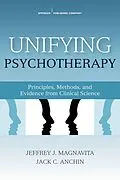With over 1,000 approaches to psychotherapy, many of which have few substantive differences, how can a therapist know which one will provide the most effective treatment? Unifiedpsychotherapy, a significant new paradigm in the evolution of psychotherapy, is a multicomponent,biopsychosocial systems model that draws from all of the major psychotherapeutic models andis grounded in the belief that a combination of theory and practice, supported by evidence-basedresearch, is the key to effective psychotherapy. This book provides a practice-friendly presentation ofthe theoretical and evidence-based foundations, principles, and methods of unified therapy.
The book offers clinicians and students a framework they can use to select from a variety of technicalinterventions based on an understanding of relational principles. It includes specific intervention strategiesthat can be used with the full spectrum of individuals suffering from psychological disorders andrelational disturbances. Unifying Psychotherapy describes a paradigm that is anchored in a holistic biopsychosocialsystems model of personality and psychopathology and encompasses four domain levelsranging from microscopic to macroscopic. Detailed assessment and treatment principles consider theinterplay between the components of all four levels of the biopsychosocial systems model. Evidence-based interventions that are clearly described along with case illustrations underscore theimportance of flexibility as an essential component in using unified psychotherapy. The book alsodiscusses current developments in psychotherapy, clinical science, and the discipline of psychologyitself as they pertain to the use of unified therapy.
Key Features:- Presents a state-of-the art examination, analysis, and appraisal of unified psychotherapyas the next wave in the evolution of the field
- Details the theoretical and evidence-based foundations, principles, and methods of aspecific unified approach to psychotherapy
- Provides an organizing metatheoretical model that drawson all domains to form a unifying framework to guidetherapeutic processes and practices
- Describes evidence-based interventions with case examples
Autorentext
Jack C. Anchin, PhD, FAPA, is adjunct professor of psychology at SUNY at Buffalo and aclinical psychologist engaged in full-time private practice for over 25 years. Dr. Anchin isalso co-editor of the Handbook of Interpersonal Psychotherapy and has published articles andchapters on the theory and practice of interpersonal psychotherapy, as well as on psychotherapyintegration and psychotherapy unification. His publications also include invitedcommentaries on relational psychoanalysis; the unification of knowledge across the naturalsciences, social sciences, and humanities; and integrative research methodology in thescientific study of interpersonal psychotherapy. Dr. Anchin has been an associate editorof the American Psychological Association (APA) Journal of Psychotherapy Integration andis currently a member of the editorial board. He has also served on the inaugural advisorycouncil of APA's Clinician's Research Digest: Briefings in Behavioral Science, and on theeditorial boards of the Journal of Integrative and Eclectic Psychotherapy and the APA journalPsychotherapy: Theory, Research, Practice, Training. With Dr. Magnavita, he is co-founder andco-editor of the electronic Journal of Unified Psychotherapy and Clinical Science. Dr. Anchin isan invited charter member of the Society for the Exploration of Psychotherapy Integration.He is a Fellow of the APA and is the 2011 recipient of the APA Division of Psychotherapy'sDistinguished Psychologist Award for contributions to psychology and psychotherapy.
Inhalt
"
Foreword
Preface
Section I: Theory and Evidence for Unifying Psychotherapy
Chapter 1: The Emergence of a Unifying Paradigm for Psychotherapy
Chapter 2: The Personality System
Chapter 3: The Relational MatrixóFundamental Principles and Processes
Section II: Unified Psychotherapeutics
Chapter 4: The Mind/Brain
Chapter 5: Self and Other Dyads
Chapter 6: Triads and Family Systems
Chapter 7: Larger Systems
Section III: Clinical Strategies of Unified Psychotherapy
Chapter 8: Unifying PsychotherapeuticsóIntrapsychic & Dyadic Levels
Chapter 9: Unifying PsychotherapeuticsóTriadic, Family, & Sociocutural Levels
Chapter 10:Formulation of Unified Treatment Packagesó
Clinical Decision-Making in Unified Therapeutics"